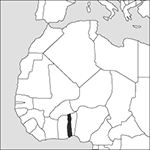
Source: MAPS IN MINUTES™ © RH Publications (1997)
Capital:
Lomé
Area:
56,785 sq km (21,925 sq miles)
Population:
7,154,237 (2013 est)
Currency:
1 CFA franc = 100 centimes
Religions:
Traditional beliefs 51.0%; Christian 29.0%; Muslim 20.0%
Ethnic Groups:
African (37 tribes) 99.0%
Languages:
French (official); Ewe; Mina; Kabye; Dagomba
International Organizations:
UN; AU; ECOWAS; Franc Zone; Non‐Aligned Movement; WTO
A West African country lying between Ghana and Benin.
Physical
Togo has a southern coastline on the Gulf of Guinea of only 56 km (35 miles) but extends inland for over 560 km (350 miles) to Burkina Faso. Northward the land rises to low mountains and a rolling sandstone plateau.
Economy
Two-thirds of the labour force work in agriculture. The leading cash crops—cocoa, coffee, and especially cotton—provide two-fifths of Togo’s export earnings. The main export industry is phosphate mining (Togo is one of the world’s leading producers of phosphates), followed by cement manufacture (Togo is Africa’s largest exporter of cement).
History
Togo’s earliest known inhabitants were Gur‐speaking Voltaic peoples in the north and Kwa peoples in the south. The Ewé immigrated during the 14th–16th centuries and the Ane (Mina) entered the region in the 17th century. Part of Togo’s slave coast was controlled by Denmark during the 18th century and the area formed a buffer zone between the Ashanti and Dahomey kingdoms. Annexed by Germany in 1884 as a colony, Togoland was mandated between France and Britain after World War I. The western British section joined Ghana on the latter’s independence in 1957, and became known as the Volta region. The remainder of the area became a UN mandate under French administration after World War II and achieved independence, as Togo, in 1960. After two civilian regimes were overthrown in 1963 and 1967, Togo achieved stability under PresidentGnassingbé Eyadéma, who in 1979 was elected executive President, as the sole candidate. Following violent demonstrations early in 1991, he agreed to legalize political parties. In 1993 Eyadéma won the country’s first multiparty presidential elections, but this result was widely considered a fraud and unrest continued. Early in 1994, fighting around the capital, Lomé, left 58 people dead. Eyadéma won further fraudulent elections in 1998 and 2003, resulting in the withdrawal of some overseas aid. When Eyadéma died in 2005, the army installed his son, Faure Gnassingbé, as President. He stood down after protests and international pressure, but was then returned to the presidency in the subsequent election. He was re-elected in 2010 and 2015.
- thermoluminescent dating
- thermolysis
- thermometer
- thermonasty
- thermoneutral zone
- thermonuclear reaction
- thermonuclear reactions
- thermonuclear reactor
- thermonuclear weapon
- thermophile
- thermophilic
- thermophilic bacteria
- thermopile
- thermoplastic
- Thermopylae
- thermoreceptor
- thermoregulation
- thermoremanent magnetization
- thermosetting
- thermosphere
- Thermosphere Ionosphere Mesosphere Energetics and Dynamics
- thermostat
- thermo-syphon reboiler
- therophyte
- Theropoda